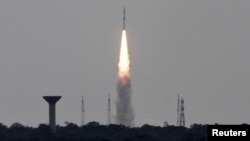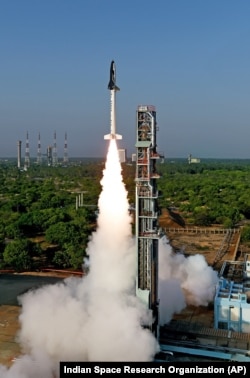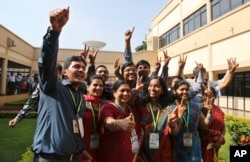Indian scientists pronounced the testing of an indigenously developed reusable space rocket this week, “Mission accomplished successfully.”
Those words have been heard increasingly in recent years from the Indian Space Research Organization (ISRO) as it quietly presses ahead with its space ambitions.
Developing a reusable rocket could still be a decade away, but the test of a miniature winged, 6.5-meter long, 1.75 tonne space vehicle signified that India has entered the race to make space exploration cheaper and easier.
Russia, Japan and the European Space Agency and private spaceflight companies like SpaceX are also developing similar technology.
The U.S. space agency NASA abandoned its reusable space shuttle program in 2011. Like airplanes, reusable space vehicles – which account for most of the cost of space exploration – can land back on earth and be launched again.
Indian scientists said that mastering the technology could slash costs to a tenth of what they are at present. That is a neat fit with India’s priority.
“We are working on low-cost access to space,” stressed ISRO spokesperson Deviprasad Karnik.
Latecomer to space race
Although a relative latecomer to the space race, India’s space program has notched up some significant technological breakthroughs and simultaneously developed a reputation for being highly cost effective.
India grabbed global attention when its unmanned Mars orbiter entered the Red planet's orbit on its very first attempt in 2014.
Not only did it become the first Asian country to carry out an interplanetary mission, it did so on a shoestring budget of $73 million – a fraction of the approximate $670 million outlay on the U.S. Maven Mars Mission.
“There is a bit of status and kind of pride associated with some of these programs. Some of the key technology demonstrations will gain India a seat at the high table,” said Rajeswari Pillai Rajagopalan, the head of Nuclear and Space Policy at at New Delhi’s Observer Research Foundation.
Buoyed by the success of its Mars Mission, the space agency is working on new launches. It is scheduled to send its second mission to study the surface of the moon next year, and has been eyeing the possibility of putting an astronaut in space.
“It is not an approved project, but we are developing parallelly the critical technologies that may be necessary for the future development,”
ISRO spokesman Karnik said about plans for a manned mission.
Navigation system
Another program that has gotten less attention, but is significant is the launch of India’s home-grown navigation satellite system, the equivalent to the U.S. Global Positioning System that it currently relies on.
Expected to be operational in a few months, the satellite system will make India the fifth after the United States, Russia, China and Europe to have its own GPS. It will cover an area of 1,500 kilometers from India’s boundaries.
“Today we are free of dependence on other countries for navigation. Our planes will be able to land with ease and accuracy, we can plan disaster relief better and with our own technology,” Prime Minister Narendra Modi said last month when the final navigational satellite was launched.
The system will provide key advantages to a country with many remote locations in high Himalayan mountains and deep deserts.
“At certain places it will be having better accuracy, and certain places where GPS signals are not available this can cater to,” Karnik said.
Tens of thousands of Indian soldiers are deployed in the high Himalayas along the country’s borders with Pakistan and China.
'Strategic reasons'
With an eye on China, India is also exploring the military applications of its space program.
“India is looking at usage of space for strategic reasons also” said Ajay Lele at the Institute for Defense Studies and Analyses in New Delhi.
“India has got a very unique position in South Asia where it is surrounded by two nuclear neighbors. So the threat perception, from that perspective India is using space assets also for the purposes of reconnaissance, communication, navigation,” Lele said.
Analysts point out that ironically, what gave India’s space program its competitive edge was the denial of access to Western technologies following the country’s 1974 nuclear test, which pushed scientists to develop home-grown technologies.
While it is important to keep costs low because India’s space program has a modest budget, those low costs have helped India exploit the commercial potential of its space program through the launch of satellites for other countries at far cheaper rates compared to Western nations.
However, Lele points out that although India is beginning to make its mark in space exploration, it still lags behind the advanced space faring nations in the West and China.
“India has got major ambitions, but India is a second-rung space power,” he said.












